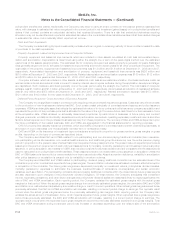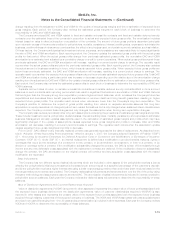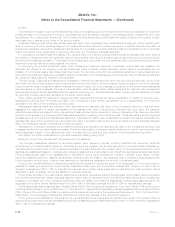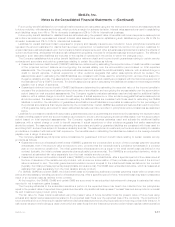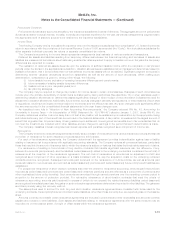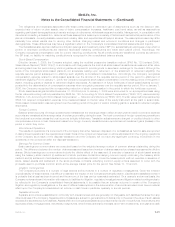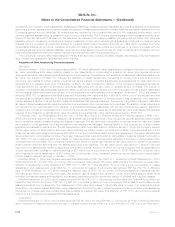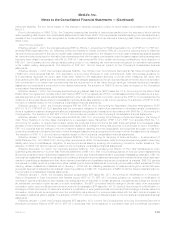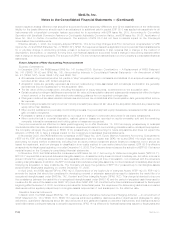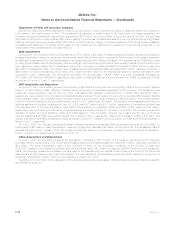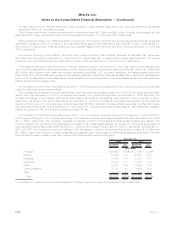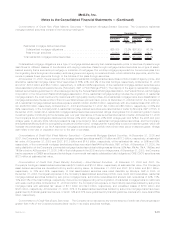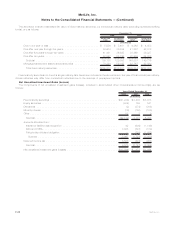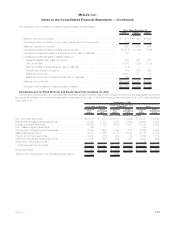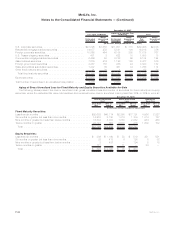MetLife 2008 Annual Report Download - page 147
Download and view the complete annual report
Please find page 147 of the 2008 MetLife annual report below. You can navigate through the pages in the report by either clicking on the pages listed below, or by using the keyword search tool below to find specific information within the annual report.It also provides guidance on the recognition, measurement, and classification of income tax uncertainties, along with any related interest
and penalties. Previously recorded income tax benefits that no longer meet this standard are required to be charged to earnings in the
period that such determination is made.
As a result of the implementation of FIN 48, the Company recognized a $35 million increase in the liability for unrecognized tax benefits
and a $9 million decrease in the interest liability for unrecognized tax benefits, as well as a $17 million increase in the liability for
unrecognized tax benefits and a $5 million increase in the interest liability for unrecognized tax benefits which are included in liabilities of
subsidiaries held-for-sale. The corresponding reduction to the January 1, 2007 balance of retained earnings was $37 million, net of
$11 million of minority interest included in liabilities of subsidiaries held-for-sale. See also Note 15.
Insurance Contracts
Effective January 1, 2007, the Company adopted SOP 05-1 which provides guidance on accounting by insurance enterprises for DAC
on internal replacements of insurance and investment contracts other than those specifically described in SFAS No. 97, Accounting and
Reporting by Insurance Enterprises for Certain Long-Duration Contracts and for Realized Gains and Losses from the Sale of Investments.
SOP 05-1 defines an internal replacement and is effective for internal replacements occurring in fiscal years beginning after December 15,
2006. In addition, in February 2007, the American Institute of Certified Public Accountants (“AICPA”) issued related Technical Practice Aids
(“TPAs”) to provide further clarification of SOP 05-1. The TPAs became effective concurrently with the adoption of SOP 05-1.
As a result of the adoption of SOP 05-1 and the related TPAs, if an internal replacement modification substantially changes a contract,
then the DAC is written off immediately through income and any new deferrable costs associated with the new replacement are deferred. If
a contract modification does not substantially change the contract, the DAC amortization on the original contract will continue and any
acquisition costs associated with the related modification are immediately expensed.
The adoption of SOP 05-1 and the related TPAs resulted in a reduction to DAC and VOBA on January 1, 2007 and an acceleration of the
amortization period relating primarily to the Company’s group life and health insurance contracts that contain certain rate reset provisions.
PriortotheadoptionofSOP05-1,DAConsuchcontractswasamortized over the expected renewable life of the contract. Upon adoption
of SOP 05-1, DAC on such contracts is to be amortized over the rate reset period. The impact as of January 1, 2007 was a cumulative
effect adjustment of $292 million, net of income tax of $161 million, which was recorded as a reduction to retained earnings.
Defined Benefit and Other Postretirement Plans
Effective December 31, 2006, the Company adopted SFAS 158. The pronouncement revises financial reporting standards for defined
benefit pension and other postretirement benefit plans by requiring the:
(i) recognition in the statement of financial position of the funded status of defined benefit plans measured as the difference
between the estimated fair value of plan assets and the benefit obligation, which is the projected benefit obligation for
pension plans and the accumulated postretirement benefit obligation for other postretirement benefit plans;
(ii) recognition as an adjustment to accumulated other comprehensive income (loss), net of income tax, those amounts of
actuarial gains and losses, prior service costs and credits, and net asset or obligation at transition that have not yet been
included in net periodic benefit costs as of the end of the year of adoption;
(iii) recognition of subsequent changes in funded status as a component of other comprehensive income;
(iv) measurement of benefit plan assets and obligations as of the date of the statement of financial position; and
(v) disclosure of additional information about the effects on the employer’s statement of financial position.
The adoption of SFAS 158 resulted in a reduction of $744 million, net of income tax, to accumulated other comprehensive income,
which is included as a component of total consolidated stockholders’ equity. As the Company’s measurement date for its pension and
other postretirement benefit plans is already December 31 there was no impact of adoption due to changes in measurement date. See also
“Summary of Significant Accounting Policies and Critical Accounting Estimates” and Note 17.
Stock Compensation Plans
As described previously, effective January 1, 2006, the Company adopted SFAS 123(r) including supplemental application guidance
issued by the U.S. Securities and Exchange Commission in Staff Accounting Bulletin (“SAB”) No. 107, Share Based Payment using the
modified prospective transition method. In accordance with the modified prospective transition method, results for prior periods have not
been restated. SFAS 123(r) requires that the cost of all stock-based transactions be measured at fair value and recognized over the period
during which a grantee is required to provide goods or services in exchange for the award. The Company had previously adopted the fair
value method of accounting for stock-based awards as prescribed by SFAS 123 on a prospective basis effective January 1, 2003. The
Company did not modify the substantive terms of any existing awards prior to adoption of SFAS 123(r).
Under the modified prospective transition method, compensation expense recognized during the year ended December 31, 2006
includes: (a) compensation expense for all stock-based awards granted prior to, but not yet vested as of January 1, 2006, based on the
grant date fair value estimated in accordance with the original provisions of SFAS 123, and (b) compensation expense for all stock-based
awards granted beginning January 1, 2006, based on the grant date fair value estimated in accordance with the provisions of SFAS 123(r).
The adoption of SFAS 123(r) did not have a significant impact on the Company’s financial position or results of operations as all stock-
based awards accounted for under the intrinsic value method prescribed by APB 25 had vested prior to the adoption date and the
Company had adopted the fair value recognition provisions of SFAS 123 on January 1, 2003.
SFAS 123 allowed forfeitures of stock-based awards to be recognized as a reduction of compensation expense in the period in which
the forfeiture occurred. Upon adoption of SFAS 123(r), the Company changed its policy and now incorporates an estimate of future
forfeitures into the determination of compensation expense when recognizing expense over the requisite service period. The impact of this
change in accounting policy was not significant to the Company’s financial position or results of operations as of the date of adoption.
Additionally, for awards granted after adoption, the Company changed its policy from recognizing expense for stock-based awards over
the requisite service period to recognizing such expense over the shorter of the requisite service period or the period to attainment of
F-24 MetLife, Inc.
MetLife, Inc.
Notes to the Consolidated Financial Statements — (Continued)


